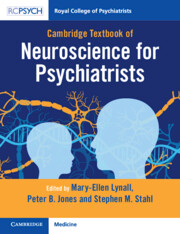Book contents
- Cambridge Textbook Of Neuroscience for Psychiatrists
- Reviews
- Cambridge Textbook of Neuroscience for Psychiatrists
- Copyright page
- Contents
- Contributors
- Introduction
- 1 Cells
- 1.1 Neurons
- 1.2 The Physiology of Neurons, Synapses and Receptors
- 1.3 Modelling Single Neurons and Their Combinations in Circuits
- 1.4 Glia
- 2 Neurotransmitters and Receptors
- 3 Basic Techniques in Neuroscience
- 4 Neuroanatomy
- 5 Neural Circuits
- 6 Modulators
- 7 Genetics
- 8 Neurodevelopment and Neuroplasticity
- 9 Integrated Neurobiology of Specific Syndromes and Treatments
- 10 Neurodegeneration
- Index
- References
1.4 - Glia
from 1 - Cells
Published online by Cambridge University Press: 08 November 2023
- Cambridge Textbook Of Neuroscience for Psychiatrists
- Reviews
- Cambridge Textbook of Neuroscience for Psychiatrists
- Copyright page
- Contents
- Contributors
- Introduction
- 1 Cells
- 1.1 Neurons
- 1.2 The Physiology of Neurons, Synapses and Receptors
- 1.3 Modelling Single Neurons and Their Combinations in Circuits
- 1.4 Glia
- 2 Neurotransmitters and Receptors
- 3 Basic Techniques in Neuroscience
- 4 Neuroanatomy
- 5 Neural Circuits
- 6 Modulators
- 7 Genetics
- 8 Neurodevelopment and Neuroplasticity
- 9 Integrated Neurobiology of Specific Syndromes and Treatments
- 10 Neurodegeneration
- Index
- References
Summary
No survey of brain cells would be complete without considering glial cells, or glia. These are non-neuronal, non-electrically active cells, which nevertheless make vital contributions to the function of neurons in the brain. Located throughout the brain, intermingled with and in close proximity to neurons, in similar numbers, they can be divided into several major types, with specific roles.
- Type
- Chapter
- Information
- Cambridge Textbook of Neuroscience for Psychiatrists , pp. 13 - 15Publisher: Cambridge University PressPrint publication year: 2023

